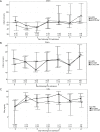No association between systemic complement activation and intensive care unit-acquired weakness
- PMID: 29955575
- PMCID: PMC6015952
- DOI: 10.21037/atm.2018.01.30
No association between systemic complement activation and intensive care unit-acquired weakness
Abstract
Background: The main risk factors for intensive care unit-acquired weakness (ICU-AW) are sepsis, the systemic inflammatory response syndrome (SIRS) and multiple organ dysfunction. These risk factors are associated with systemic complement activation. We hypothesized that critically ill patients who develop ICU-AW have increased systemic complement activation compared to critically ill patients who do not develop ICU-AW.
Methods: Complement activation products C3b/c, C4b/c and C5a were measured in plasma of ICU patients with mechanical ventilation for ≥48 hours. Samples were collected at admission to the ICU and for 6 consecutive days. ICU-AW was defined by a mean Medical Research Council (MRC) score <4. We compared the level of complement activation products between patients who did and who did not develop ICU-AW.
Results: Muscle strength measurements and complement assays were available in 27 ICU patients, of whom 13 patients developed ICU-AW. Increased levels of C4b/c were seen in all patients. Neither admission levels, nor maximum, minimum and mean levels of complement activation products were different between patients who did and did not develop ICU-AW.
Conclusions: Complement activation is seen in critically ill patients, but is not different between patients who did and who did not develop ICU-AW.
Keywords: Complement activation; critical illness myopathy; critical illness polyneuropathy; intensive care unit-acquired weakness (ICU-AW); systemic inflammation.
Conflict of interest statement
Conflicts of Interest: Prof. IN van Schaik received departmental honoraria for serving on scientific advisory boards and a steering committee for CSL-Behring. The other authors have no conflicts of interest to declare.
Figures

References
LinkOut - more resources
Full Text Sources
Other Literature Sources
Miscellaneous
